High-Resolution Younger Dryas
Environmental Variability:
A Comprehensive Assessment from Mid-North America
P.I. Irina P. Panyushkina and co-P.I. Steven W. Leavitt (Support from NSF ATM-0213696)
The warming
from Late Glacial to Early Holocene was interrupted by an abrupt,
millennial-length cold climate excursion known as the Younger Dryas
(YD) event. Effects of this event seem
to be widespread, but knowledge of the character of the YD in Europe
far exceeds that of other locations such as mid-North America America
Floating
ring-width chronologies are being developed for each site/time, using
radiocarbon dates to position the sites in the Late Glacial-Early Holocene time
frame. They will not produce a single
chronology, but will provide an effective ensemble of chronologies over the
4,000 14C-yr time interval with which to investigate fine-scale
climate change. Contingent on resources,
high-resolution environmental information will be extracted at each site/time
using ring-width chronologies, event chronologies (eg,
frost rings, light rings, reaction wood), stable isotope analysis (dD, d13C and d18O) and xylem anatomy measurements (radial lumen diameter, cell-wall
thickness). Sophisticated spectral
analysis techniques will be applied to the ring-width chronologies to estimate
frequency of climate-related variability at particular band-widths, especially
associated with global teleconnections (eg, ENSO, NAO, PDO, AO).
Finally, high-resolution radiocarbon records will be developed to
precisely match existing radiocarbon chronologies by “wiggle matching”, and
more importantly to exploit fine-scale differences between existing records
from Europe , Japan Australia Cariaco Basin
This systematic study will
provide the first high-resolution portrait of the Late Glacial/Early Holocene
transition in mid-N.
Updated
Project Summary (3-07)
TREE-RING SITES UNDER INVESTIGATION

MAP. Location of buried wood sites (tree-ring sites)
n- conifer and l- deciduous wood.
N- new
sites, V- vanished sites, P- in press (Panyushkina et al., Radiocarbon 2004)
F1=
Fig.1 (2, 3, etc)
SITES WITH EXTENDED
TREE-RING WIDTH CHRONOLOGIES
Pre-Younger Dryas
Two Creeks (13,500-13,800 Cal y BP)
Fig. 1. Sample Depth of Two Creeks site chronology from 3 collections: 296-year length, 55 trees, Std. Dev. of tree-ring indices 0.22

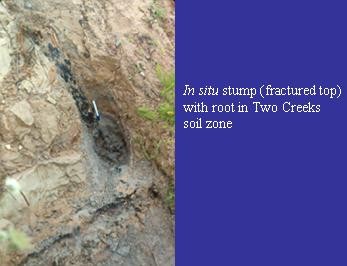
Younger Dryas
Liverpool East (11,700-12,350 Cal y BP)
Fig. 2. Sample depth of Liverpool site chronology: 131-year
length, 19 trees, Std. Dev. of tree-ring indices 0.23
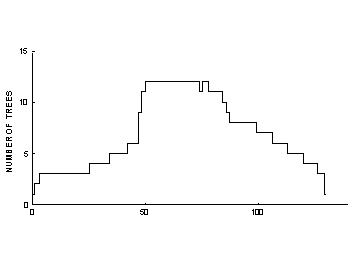
Photo 1,2 . Largest stump (73-cm circumference) in upright
position found in 2004 (left) and tilted smaller spruce stumps on east side of
drainage ditch (right).
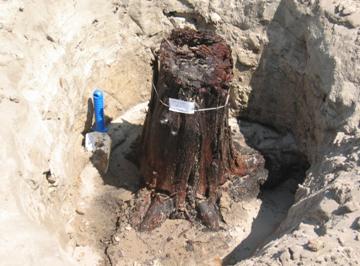
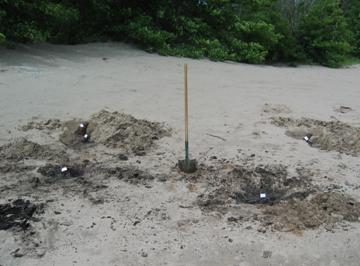
Late- to Post-Younger Dryas
Gribben Basin (11,200-11,600 Cal y BP)
Fig. 3. Sample depth of Gribben Basin
site chronology: 178-year length, 32 trees, Std. Dev. of tree-ring indices 0.24
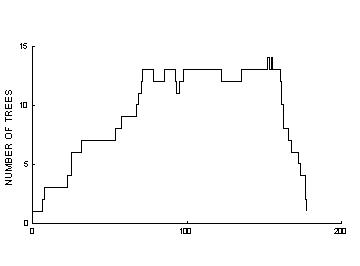
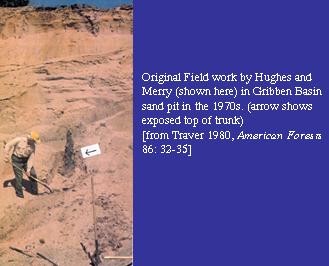
New Sites
Photo 3,4. Mason site,
WI: Retention pond excavation adjacent to Amerihost
Motel off Mason Road exit of I-43, Green Bay
Red till containing wood of apparent Two Creeks
equivalence above very sandy grey till or lake sediment (left). Spruce logs
scraped by excavator (right).
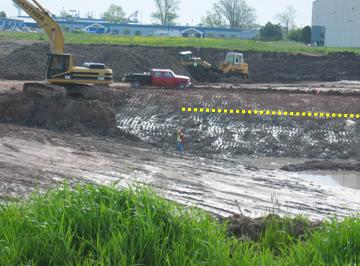
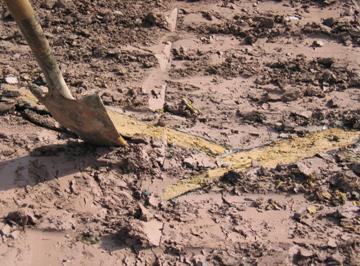
Photo 5,6. Brewster site, IL: 12,800-13,000 Cal y BP
Removing irrigation tiles from abandoned fields in W.
Chicago area (left).
Ditch profile with two layers of buried peat with wood (right). (photos by M. Zoellner)
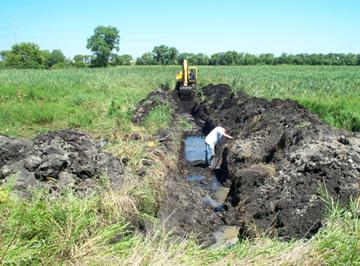
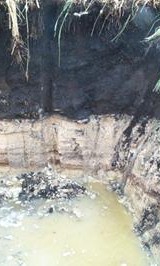
Fig. 4. Averaged series: 65-year
length, 7 tree-ring series from 3 trees, Std. Dev. of tree-ring indices 0.57
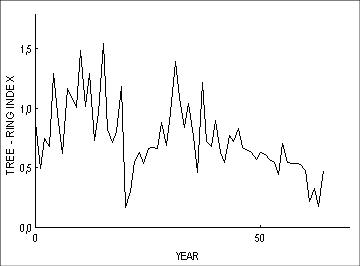
Rediscovered Site
Photo 7,8. Brown's Sand Pit
site, IN: 13,500 Cal y BP exposure overgrown between Sept. 1987 (left)
and in Jun. 2004 (right).
[The photos were taken from near the same position in 1987
and 2004 (the E-W oriented water ditch appears in both photos). The slope with TwoCreekan wood exposure is marked with red line.]
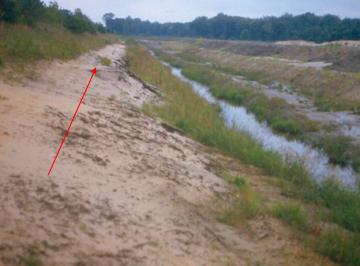
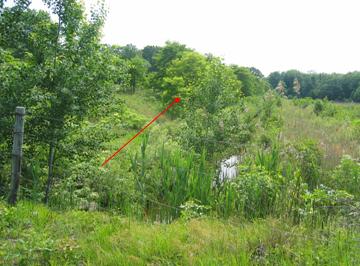
Other
Photo 9. Lincoln
Quarry, IL (log 6,320 BP)

Publications
and Presentations:
Publications-
Hunter, R.D., Panyushkina, I.P.,
Leavitt, S.W., Wiedenhoeft, A.C. and Zawiskie, J., 2006. A multiproxy
environmental investigation of Holocene wood from a submerged conifer forest in
Mode, W.N., Panyushkina,
I.P., Leavitt, S.W., Williams, J.W., Sanitiago, A.,
Gill, J., Edwards, C., Gertz, H., 2007. Stop 9.
Late-glacial and early Holocene paleoecology:
Schneider farm,
Panyushkina, I.P., Leavitt, S.W., 2007. Insights
into Late Pleistocene/Early Holocene paleoecology
from fossil wood around the
Panyushkina, I.P., Leavitt, S.W., Wiedenhoeft,
A., Noggle S., Curry, B.
and Grimm, E., 2004. Tree-ring records of near-Younger Dryas time in Central N.
America- Preliminary results from the Lincoln Quarry site, central
Leavitt,
S.W., Panyushkina, I.P., Lange, T., Cheng, L.,
Schneider, A.F., Hughes, J., 2007.
Radiocarbon “wiggles” in
Leavitt,
S.W., Panyushkina, I.P., Lange, T., Wiedenhoeft, A., Cheng, L., Hunter, R.D., Hughes, J., Pranschke, F., Schneider, A.F., Moran, J., and Stieglitz,
R., 2006. Climate in
the
Presentations-
Panyushkina, I.P., Leavitt, S.W., 2006. Late Glacial-Early Holocene Climate Variability in the
Panyushkina, I.P. and Leavitt, S.W., 2003. Tree-ring
investigation of the Younger Dryas in the U.S. Upper
Midwest. XVI INQUA Congress,
Panyushkina, I.P. and Leavitt, S.W., 2004. High-resolution records of
the Pleistocene-Holocene transition from tree rings in central
Panyushkina, I.P., Leavitt, S.W., Lange, T., Schneider, A.F., 2005, Tree-Ring Investigation of an in situ Younger Dryas-Age Spruce Forest in the Great Lakes Region of N. America, AGU Fall Meeting (5-9 Dec.), Eos Trans. AGU, 86(52), Fall Meet. Suppl., Abstract PP13A-1484.
Panyushkina, I.P., Leavitt, S.W. and Noggle,
S., 2002. A tree-ring study of wood of possible Younger Dryas age from central
Leavitt, S.
and Panyushkina,
Leavitt, S.W., Panyushkina, I.P. and Lange, T. 2006. Radiocarbon “Wiggles”
in Great Lakes Wood ca.10,000 to 12,000 BP. 19th International Radiocarbon
Conference, 3-7 April 2006
[updated
June 21, 2007]